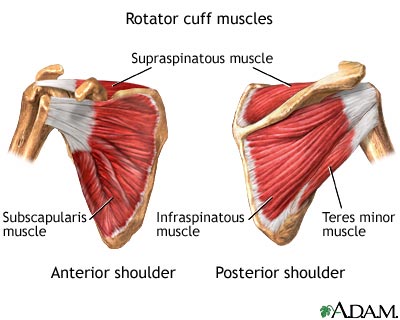 This article is for every athlete out there who are having pitching shoulder problems. I am an athlete, who overcame a career ending rotator cuff tear in college, to pitch again and make it to minor league ball. I was told I would never pitch as hard as I did before the tear. I topped out at 94 mph my last season for the San Diego Surf Dawgs, over seven years later. That was more than 8 mph from before surgery. It was a long road and I am here today to teach you everything you need to know on how to prevent this from happening to you.
This article is for every athlete out there who are having pitching shoulder problems. I am an athlete, who overcame a career ending rotator cuff tear in college, to pitch again and make it to minor league ball. I was told I would never pitch as hard as I did before the tear. I topped out at 94 mph my last season for the San Diego Surf Dawgs, over seven years later. That was more than 8 mph from before surgery. It was a long road and I am here today to teach you everything you need to know on how to prevent this from happening to you.
Before we get started I would suggest you take some time just to read this picture and learn the muscles of the shoulder. This will help you understand your pain and problems better.
In this article, I will not only help you learn how to prevent shoulder surgery but how to diagnose the pitching shoulder problem.
How to Prevent Pitching Shoulder Surgery
As I said, you must learn the small muscle of the rotator cuff from the picture above. These muscles are your career. They are here to internally and externally rotate your arm. The most important information to remember about these muscles are that they can only handle around 5 pounds of pressure each. The deltoids take over if the pressure exceeds this amount. So this means, all we need is 3 to 5 pounds to strengthen the rotator cuff muscles. Anything more will prevent you from isolating them properly for development.
The most important muscle of the rotator cuff, for throwers, is the supraspinatus. This muscle lives under the acromion tip of the clavicle. This is the end of the collarbone. This muscle takes a lot of abuse when the elbow is above the pitching shoulder. This is because it is being impinged by the acromion tip. If your arm is internally rotated too far forward, when you pull your arm back to throw, this can cause the supraspinatus to "pop" or "grind" under the acromion. Over time, this can tear the muscle. To prevent this impingement, you must learn good throwing mechanics and how to build joint integrity. You can not do one without the other when trying to prevent an injury.
You can learn the correct mechanics to prevent injury from the 3X Pitching Velocity program. To build joint integrity, you need two 3 or 5-pound weights to get started. All of the exercises you will need are listed in the AcePitcher Handbook.
The first sign of poor joint integrity is posture. If you are someone who slouches over when sitting or standing, this could be a sign of poor pitching shoulder joint integrity. Another sign is when the ball of the pitching shoulder socket is protruding forward past the chest and the pitching shoulder blade is sticking out like a wing. This means that the anterior muscles are stronger than the posterior muscles. This is the definition of poor joint integrity. This will lead to a pitching shoulder injury.
Common pain that is a sign of impingement is usually referred to as pain from the supraspinatus. Most of the pain from the cuff is referred to as pain. Referred pain means pain that originates in one part of the body, but is felt in another part of the body. If you feel pain on the outside of your arm, between the bicep and tricep muscles, just below the mid-deltoid, then this is an impingement. Don't be alarmed, it isn't a tear. The supraspinatous is probably inflamed. This can be remedied with ice. You should only ice your arm for 15-20 minutes on and 15-20 minutes off. You can repeat the process but any more than 15-20 minutes on, can cause nerve damage. Always finish with ice. Never finish with heat. Heat inflames the muscle tissue, and when the tissue is inflamed, it isn't healing. It is also not a good idea to ice an arm just after pitching. It is best to flush the system. This is when you do some good sprints, to get your heart beating, so you can get your blood pumping. This will help flush the breakdown of waste from pitching out of your arm. Then you can ice. Also never ice your Ulnar nerve. You can also take anti inflammatories, recommended by your Doctor. This is a symptom you can pitch through, but remember when the supraspinatous is inflamed, this will cause more wear and tear on the cuff. So try hard to take care of it ASAP.
How to identify and deal with a Rotator Cuff Tear for a Pitcher
The sign of a rotator cuff tear is very obvious. You have a considerable loss of movement in your arm, with serious pain. If the supraspinatus is torn, which is the most common tear for throwers, you will not be able to turn your hand thumb down and raise it straight out in front of your body. This is because this movement requires a lot of work from the supraspinatous. If this is the case I am sure you have already seen a Doctor and unfortunately you need surgery. This was my case. It is a hard reality to face. Especially when you are 18 like I was. There was one moment that got me thinking positively and it was a saying I saw on a wall just after the Doctor diagnosed the tear. "Where there is a Will, there is a Way." Every six months the body regenerates itself. This means every muscle has grown new tissue from the inside out. Like your skin. If you can get yourself on the right track, you can start over again and this is exactly what it will feel like. You are starting over at this point and you may not get another chance. It is a tough road but laced with so many rewards. If you are someone who is post-surgery and needs a little boost to get back to the game you love, then please contact me and I will get you on the right track.
In conclusion, your rotator cuff is your life support as a pitcher. It is like a pair of tires that you can never change on your race car. It is vital that you learn how to take care of it if you want to play well into your twenties and beyond. I hope this article gets you going and please contact me with any questions or post them in the discussion board.
The #1 Training Program for the Pitching Shoulder
 This program has helped tons of pitchers live the dream of throwing 90+mph and signing with a D1 University, getting drafted by a Major League Organization, and making it back to Major League Baseball. Many scouts in all organizations of baseball have recommended this program to help young pitchers get to the 90+mph range to improve their value at the next level.
This program has helped tons of pitchers live the dream of throwing 90+mph and signing with a D1 University, getting drafted by a Major League Organization, and making it back to Major League Baseball. Many scouts in all organizations of baseball have recommended this program to help young pitchers get to the 90+mph range to improve their value at the next level.
The reason the 3X Extreme Pitching Velocity Program works is because it is based on science and it has been proven to develop the 90+mph fastball on thousands of pitchers. It isn't rocket science or voodoo, it is the real deal! The program comes with a high-level workload of drills, lifts, and exercises scientifically programmed to enhance throwing speed on the mound while developing an efficient pitching delivery. The format of the 3X Pitching Velocity Program is similar to the approach Olympic throwers have been using for decades to increase throwing velocity. This approach isn't new to the sports world but it is new to baseball.
If you are serious about your career and are insanely driven to put yourself into an extremely small percentage of pitchers who are potential D1 prospects, top-level draft picks or you just want to reach your potential on the mound then this program is the best chance you have to making your dreams come true.
Learn more about the 3X Extreme Pitching Velocity Program or get started TODAY adding 5-10+mph!





My son who is seeing a physical therapist, has pain in the upper inside of his arm from shoulder to half way down his upper arm. He has been pitching since he was 9 or 10 and is 12 this year. He has nerve issues in his neck, SICK scapula and possible some small tears in the rotator cuff, although the "tears" have not been looked at with MRI only the thought of the therapist. Will my son be able to continue pitching? And by the way he is playing now, not pitching, but he is hitting and playing 1st base. Any insight?
It sounds like he has an impingement of his supraspinatus. This is the top rotator cuff muscle that runs underneath the clavicle. If it is torn or is frayed then this will cause pain from the shoulder down the arm to just above the elbow. If he cannot turn his thumb down and lift his arm straight out in front of his body to shoulder height then he has some damage. The neck pain and his shoulder pain is caused by wiping the arm around the body with a lot of force during his throws. It sounds like he has or had a good arm and he has abused it. I hate to hear this happening to such a young ball player.
Yes he can pitch again but he must learn how to use the total body to throw the ball instead of only his arm. If he continues to just wipe his arm, his career will be very short. He needs to learn how to get the body, especially the core and legs more involved when pitching/throwing and this will take the stress off of the neck and rotator cuff. I have a Velocity Camp in July that he should come too. This way he can learn firsthand what it takes to learn total body mechanics. You can get more info on the camp here http://www.GuerillaBaseball.com/camps . If you cannot make it then I would suggest reading more articles on http://www.TopVelocity.net .
I wish you two the best!
Wow,
Only 12yrs. old and having those types of unnecessary body throwing injury's.
Like Brent advised you, attend his velocity camp and if you cannot do so check his Top Velocity.net, and do your very best to find an experienced and knowledgeable "Pitching Teacher" in your area who can and will "Teach" him on a regular basis, some one who has been taught how to teach, not just coach who can set him up with at least "2" constructive bull pens per. week who can teach your son, after he gets fully recovered how to use his whol;e body instead of his arm only, Most people are under the impression that the throwing motion and power "velocity" are generated through the upper body and arm only "NOT SO," just like hitting and/or throwing every thing is energetically generated from the ground up with "NEGATIVE" "REVERSE" "ROTATIONAL" TO POSITIVE" "FORWARD" ROTATIONAL" movements ,Especially in pitching one urgently must learn to use their whole body from the ground up with proper body and throwing mechanics, along with a nice long body length stride directly down the line towards the intended target, I have a beautiful 3rd base side "view" of Matt Morris former Cardinals pitcher I could make a color copy of and send you if you would be interested in viewing it, and the beautiful picturesque display of proper pitching form, His push off, stride length to landing is not quite as exaggerated as TIm Lincecum of the Giants is but it is as good as it gets unless one wants to get out of the box and get that extra maximum push and stride length that Tim Lincecum has, Those who want to expand their push and stride length need to do so in very small "6" increments to get accustomed to the the feel of the adjustments being made with the full foot and extra longer foot contact push off the rubber and added stride length.I observe many games at all levels and age groups including Pro- Ball which I had the opportunity to play and there are very few exoerienced and knowledgeable "PITCHING" "TEACHERS" in the whole baseball world,This includes major league baseball also,"YES" there are many who have played minor and major league ball for several seasons but for the most part they are not experienced and knowledgeable teachers, they may be able to teach someone how to play on their level but certainly not on other lower levels, the very reason that there are only a hand full of people including on the major league level who can actually teach how to properly use the whole body during the throwing process, Any one doubting my comments "observe", "not just spectate," ball games of all levels and age groups including all minor and major league games you can, closely observe the pitchers and you will see throwing not pitching ,and the momentum and any power generated will be done so after the stride is slowly made into motion with the upper body and arm being the only source of momentum and forward explosive energy and be sure to notice the body never getting to the finish position which very few throwers are familiar with because they never get to the finish position and how the arm violently recoils back and all of the throwing power generated is "DISSIPATED" into the weaker muscles of the upper body instead of "DISSIPATING" into the stronger muscles of the lower body and allowing the arm to momentarily relax. I am appalled at the enormous number of youngsters from ages as low as 12yrs,old and up and including the major leaguer's who have unnecessary, chronic arm problems, have had arm surgeries or are waiting to have some type of surgery, My suggestion is do not put your youngsters physical being in jeopardy, find a way for them to learn how to throw and pitch by using their body's to execute their movements from the ground up to alleviate the abuse and tension that the unnatural highly explosive act of throwing a base ball creates, The sight of the arm in an animated throwing action of a fast ball is to me totally scary, The shoulder, fore arm and the elbow looks as if it is going to literally explode and fly out of their sockets, Hopefully you are having your son treated by someone who is highly experienced in treating and operating on baseball injuries.
Did your therapist give the ok to play and throw? Did you get more than one check up and opinion? it sounds like he needs to let it rest so the treatment will not have any interference during the healing process, as you can tell I am very cautious about these types of injuries.
I wish him a speedy and successful recovery, and much success in his baseball endeavors.
Don Ervin
kom_ervin@yahoo.com